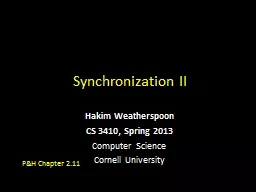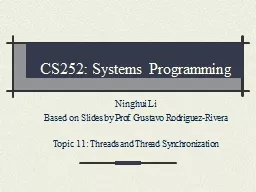PPT-Synchronization Threads, data races, locks
Author : webraph | Published Date : 2020-06-23
Sections 124 125 Instructor Haryadi Gunawi Threads Contd Sharing and memory model Threads and Process address space Code segment Each thread has a program counter
Presentation Embed Code
Download Presentation
Download Presentation The PPT/PDF document "Synchronization Threads, data races, loc..." is the property of its rightful owner. Permission is granted to download and print the materials on this website for personal, non-commercial use only, and to display it on your personal computer provided you do not modify the materials and that you retain all copyright notices contained in the materials. By downloading content from our website, you accept the terms of this agreement.
Synchronization Threads, data races, locks: Transcript
Download Rules Of Document
"Synchronization Threads, data races, locks"The content belongs to its owner. You may download and print it for personal use, without modification, and keep all copyright notices. By downloading, you agree to these terms.
Related Documents














